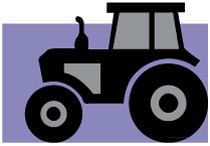April 2019
| Article submitted by a retired farmer |  |
Farmers have experienced very variable and abnormal rainfall patterns during the 2018/2019 production season. Climate change has really become a huge factor in all dryland crop production with a smaller impact on irrigation farmers. Even the climatologists and weather forecasters were unsure in their predictions of expected rainfall patterns.
Some areas may have been able to plant at the optimum planting time for dryland production. Other farmers would have been able to plant part of the crop and then been able to continue planting after intermittent thunderstorms. They would have a spread of soybeans at various phases depending on the rainfall patterns experienced in their province or farming district.
Irrigation farmers should have been able to plant at the optimum time as planned. Just about all production areas experienced very high or even abnormal heat units during the production cycle.
Most soybean lands planted in the optimum planting window between the beginning of October to the end of November 2018 will have been harvested during March and April of 2019.
HOW DO YOUR RESULTS COMPARE?
Depending on your actual planting date and if your farm is in a cool, moderate or warm production area, the average days of all cultivars could cover a range of values or benchmarks for various crop physiological growth stages and yields as shown in Table 1.
 The National average yield per hectare for the 2017/2018 production season can be calculated from the Crop Estimates Committee (CEC) final report at 1,97 t/ha, corrected to about 2,00 t/ha, from a total crop of 1 550 800 tons from a planted are of 787,000 ha’s.
The National average yield per hectare for the 2017/2018 production season can be calculated from the Crop Estimates Committee (CEC) final report at 1,97 t/ha, corrected to about 2,00 t/ha, from a total crop of 1 550 800 tons from a planted are of 787,000 ha’s.
These results indicate that using cultivar trial yield results as a guideline for cultivar choice on your farm are very useful but that the actual average yields harvested fall quite short of the yields possible. You will have determined what soybean yields from the various cultivars used that were realised on your farm by now. These can be compared to those of other soybean farmers in your district and then to the cultivar trial yield ranges that were planted near you and then the national average.
It will be the ideal time to determine which ones performed the best on your farm with a view to being able to order the right cultivars for the coming 2019/2020 season. It is always best to have a range of suitable cultivars to plant within the planting windows allowed by the variable rainfall patterns that might also be experienced in future.
CONSIDERATIONS FOR CULTIVAR AND GROWTH PARAMETERS
Soybean production areas in South Africa are determined by the altitude or location of a farm or district above sea level. The cooler production areas are located in the eastern, higher-lying characterised by a shorter production season with moderate summer days and relatively higher rainfall.
The moderate production area generally has a longer production season with warmer days and average rainfall. In effect, more heat units for growth than the cooler areas. The warm production areas have a longer growing season, with warmer days (more heat units) and little rainfall which is more suited to production under irrigation.
A basic rule of thumb is that the more heat units available, in a particular production environment during the growing season, the later you can plant. In moderate and cooler areas, the crop should be planted to obtain best results. (Please refer to the excellent and informative article: ‘When to plant soybeans’ by Nico Barnard, Research Agronomist, Pannar Seed, which was published in the November 2015 Pula Imvula for a detailed discussion on the above).
GROWTH CLASSES
Growth class choice is based on the dark hours required for the control of the vegetative and onset of flowering phases and differs for each main cultivar choice made and will be a factor to consider within the deliberations to find the right cultivar for your farm conditions. In general growth class 4,5 to 6,5 are used in the cool area’s and 5 to 7 in the moderate to warm areas. If you are not familiar with these concepts, please ask your seed supplier or consultant for more information on this aspect of choosing the correct cultivars for your circumstances.
OTHER MANAGEMENT FACTORS
Cultivar choice was highlighted above as one of the primary factors contributing to maximising yields. Other factors to analyse in depth for success are the efficiency and extent of nodulation, soil fertility and fertilisation, and weed control.
Did you plant on time and achieve the planned plant population and emergence planned? If the results for each land were recorded and your crop scouting was thorough you will be aware of what factors were most important and could have been managed or implemented in a better way.
Most important: Did you harvest quality seed and sell your crop well to realise the maximum price possible?
CONCLUSION
Use the results of a difficult season in order to make the best plan for the next.
Publication: April 2019
Section: Pula/Imvula